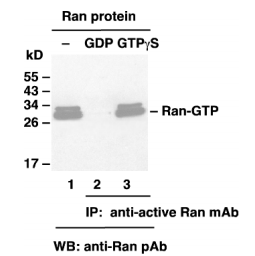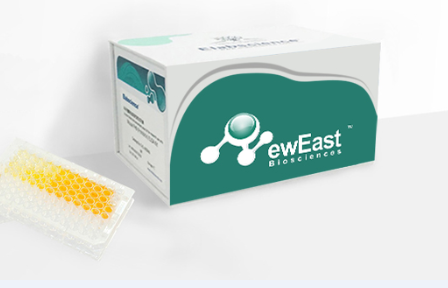厂商 :武汉纽斯特生物技术有限公司
湖北 武汉市- 主营产品:
- G蛋白活性
- cAMP和cGMP ELISA试剂盒
- 蛋白点突变

Configuration-specific Monoclonal Antibody Based Ran Activation Assay Kit Catalog Number:81701 20 assays Product Description Small GTPases are a super-family of cellular signaling regulators. Ran (Ras-related nuclear protein) is a member of the Ras-superfamily GTPases. Ran is invovled in the transport of proteins across the nuclear envelope, as well as in microtubule organization during mitosis. Currently there is no direct assay to measure the activation of Ran GTPases. NewEast Biosciences Ran Activation Assay Kit is based on the configuration-specific monoclonal antibody that specifically recognizes Ran-GTP, but not Ran-GDP. Given the high affinity of monoclonal antibodies to their antigens, the activation assay could be performed in a short time. This assay provides the reliable results with consistent reproducibility. These anti-Ran-GTP monoclonal antibodies can also be used to monitor the activation of Ran in cells and in tissues by immunohistochemistry. NewEast Biosciences Ran Activation Assay Kit provides a simple and fast method to monitor the activation of Ran. Each kit provides sufficient quantities to perform 20 assays. Assay Principle NewEast Biosciences Ran Activation Assay Kit bases on the configuration-specific anti-Ran-GTP monoclonal antibody to measure the active Ran-GTP levels, either from cell extracts or from in vitro GTPγS loading Ran activation assays. Briefly, anti-active Ran mouse monoclonal antibody will be incubated with cell lysates containing Ran-GTP. The bound active Ran will then be pulled down by protein A/G agarose. The precipitated active Ran will be detected by immunoblot analysis using anti-Ran rabbit polyclonal antibody. Kit Components 1. Anti-active Ran, Mouse Monoclonal Antibody (Catalog No. 26915): One vial – 22 ?L (1 mg/ml) in PBS, pH 7.4, containing 50% glycerol and 0.05% sodium azide. This antibody specifically recognizes Ran-GTP from all vertebrates. 2. Protein A/G Agarose (Catalog No. 30301): One vial – 400 ?L of 50% slurry. 3. 5X Assay/Lysis Buffer (Catalog No. 30303): One bottle – 30 mL of 250 mM Tris-HCl, pH 8, 750 mM NaCl, 50 mM MgCl2, 5 mM EDTA, 5% Triton X-100. 4. Anti-Ran, Rabbit Polyclonal Antibody (Catalog No. 21097): One vial – 22 ?L (1 mg/ml) in PBS, pH 7.4, contained 50% glycerol. 5. 100 X GTPγS (Catalog No. 30302): One vial –100 ?l at 10 mM, use 5 ?L of GTPγS for GTP-labeling of 0.5 mL of cell lysate. 6. 100 X GDP (Catalog No. 30304): One vial –100 ?l at 100 mM, use 5 ?L of GDP for GDP-labeling of 0.5 mL of cell lysate. Storage Store all kit components at 4?C until their expiration dates. Materials Needed but Not Supplied 1. Stimulated and non-stimulated cell lysates 2. Protease inhibitors 3. 4 °C tube rocker or shaker 4. 0.5 M EDTA, pH8.0 5. 1 M MgCl2 6. 2X reducing SDS-PAGE sample buffer 7. Electrophoresis and immunoblotting systems 8. Immunoblotting wash buffer such as TBST (10 mM Tris-HCl, pH 7.4, 0.15 M NaCl, 0.05%Tween-20) 9. Immunoblotting blocking buffer (TBST containing 5% Non-fat Dry Milk or 3% BSA) 10. PVDF or nitrocellulose membrane 11. Secondary Antibody 12. ECL Detection Reagents Reagent Preparation ? 1X Assay/Lysis Buffer: Mix the 5X Stock briefly and dilute to 1X in deionized water. Just prior to usage, add protease inhibitors such as 1 mM PMSF, 10 ?g/mL leupeptin, and 10 ?g/mL aprotinin. Sample Preparation Adherent Cells 1. Culture cells (one 10-cm plate, ~ 107cells) to approximately 80-90% confluence. Stimulate cellswith activator or inhibitor as desired. 2. Aspirate the culture media and wash twice with ice-cold PBS. 3. Completely remove the final PBS wash and add ice-cold 1X Assay/Lysis Buffer to the cells (0.5- 1 mL per 10 cm tissue culture plate). 4. Place the culture plates on ice for 10-20 minutes. 5. Detach the cells from the plates by scraping with a cell scraper. 6. Transfer the lysates to appropriate size tubes and place on ice. 7. If nuclear lysis occurs, the cell lysates may become very viscous and difficult to pipette. If this occurs, lysates can be passed through a 27?-gauge syringe needle 3-4 times to shear the genomic DNA. 8. Clear the lysates by centrifugation for 10 minutes (12,000 x g at 4 °C). 9. Collect the supernatant and store samples (~1-2 mg of total proteins) on ice for immediate use, or snap freeze and store at - 70 °C for future use. Suspension Cells 1. Culture cells and stimulate with activator or inhibitor as desired. 2. Perform a cell count, and then pellet the cells by centrifugation. 3. Aspirate the culture media and wash twice with ice-cold PBS. 4. Completely remove the final PBS wash and add ice-cold 1X Assay/Lysis Buffer to the cell pellet (0.5 – 1 mL per 1 x 107cells). 5. Lyse the cells by repeated pipetting. 6. Transfer the lysates to appropriate size tubes and place on ice. 7. If nuclear lysis occurs, the cell lysates may become very viscous and difficult to pipette. If this occurs, lysates can be passed through a 27?-gauge syringe needle 3-4 times to shear the genomic DNA. 8. Clear the lysates by centrifugation for 10 minutes (12,000 x g at 4 °C). 9. Collect the supernatant and store samples on ice for immediate use, or snap freeze and store at - 70 °C for future use. In vitro GTPγS/GDP Protein Loading for positive and negative controls Note: In vivo stimulation of cells will activate approximately 10% of the available Ran, whereas in vitro GTPγS protein loading will activate nearly 90% of the Ran. 1, Aliquot 0.5 ml of each cell extract to two microfuge tubes (or use 1 ?g of purified Ran protein). 2, To each tube, add 20 ?l of 0.5 M EDTA (to 20 mM final concentration). 3, Add 5 ?l of 100 X GTPγS (to 100 ?M, final concentration) to one tube (positive control). 4, Add 5 ?l of 100 X GDP (to 1 mM, final concentration) to the second tube (negative control). 5, Incubate the tubes at 30°C for 30 minutes with agitation. 6, Stop loading by placing the tubes on ice and adding 32.5 ?l of 1 M MgCl2 (to 60 mM, final concentration). Assay Procedure I. Active Ran Pull-Down Assay 1. Aliquot 0.5 – 1 mL of cell lysate to a microcentrifuge tube. 2. Adjust the volume of each sample to 1 mL with 1X Assay/Lysis Buffer. 3. Add 1 ?l anti-active Ran monoclonal antibody to the tube. 4. Thoroughly resuspend the protein A/G Agarose bead slurry by vortexing or titurating. 5. Quickly add 20 ?L of resuspended bead slurry to each tube. 6. Incubate the tubes at 4 °C for 1 hour with gentle agitation. 7. Pellet the beads by centrifugation for 1 min at 5,000 x g. 8. Aspirate and discard the supernatant, making sure not to disturb/remove the bead pellet. 9. Wash the bead 3 times with 0.5 mL of 1X Assay/Lysis Buffer, centrifuging and aspirating each time. 10. After the last wash, pellet the beads and carefully remove all the supernatant. 11. Resuspend the bead pellet in 20 ?L of 2X reducing SDS-PAGE sample buffer. 12. Boil each sample for 5 minutes. 13. Centrifuge each sample for 10 seconds at 5,000 x g. II. Electrophoresis and Transfer 1. Load 15 ?L/well of pull-down supernatant to a polyacrylamide gel (17%). Also, it’s recommended to include a pre-stained MW standard (as an indicator of a successful transfer in step 3). 2. Perform SDS-PAGE following the manufacturer’s instructions. 3. Transfer the gel proteins to a PVDF or nitrocellulose membrane following the manufacturer’s instructions. III. Immunoblotting and Detection (all steps are at room temperature, with agitation) 1. Following the electroblotting step, immerse the PVDF membrane in 100% Methanol for 15 seconds, and then allow it to dry at room temperature for 5 minutes. Note: If Nitrocellulose is used instead of PVDF, this step should be skipped. 2. Block the membrane with 5% non-fat dry milk or 3% BSA in TBST for 1 hr at room temperature with constant agitation. Incubate the membrane with anti-Ran polyclonal antibody, freshly diluted 1:50~1000 (depending on the amount of Ran proteins in your samples) in 5% non-fat dry milk or 3% BSA/TBST, for 1-2 hr at room temperature with constant agitation or at 4oC overnight. 3. Wash the blotted membrane three times with TBST, 5 minutes each time. 4. Incubate the membrane with a secondary antibody (e.g. Goat Anti-Rabbit IgG, HRP-conjugate), freshly diluted 1:1000 in 5% non-fat dry milk or 3% BSA/TBST, for 1 hr at room temperature with constant agitation. 5. Wash the blotted membrane three times with TBST, 5 minutes each time. 6. Use the detection method of your choice such as ECL. Example of Results The following figure demonstrates typical results seen with NewEast Biosciences Ran Activation Assay Kit. One should use the data below for reference only. QQ截图20191118145815.png Ran activation assay. Purified Ran proteins were loaded as a control (lanes 1) or immunoprecipitated after treated with GDP (lane 2) or GTPγS (lane 3). Immunoprecipitation was done with the anti-active Ran monoclonal antibody (Cat. No. 26915). Immunoblot was with an anti-Ran polyclonal antibody (Cat. No. 21097). Related Products Catalog# Name Size Price 26915 Active Ran-GTP Monoclonal Antibody 30 μL ¥4800 26020 Anti-Ran Mouse Monoclonal Antibody 100 μL ¥2800 Publications: 1. NMDAR signaling facilitates the IPO5-mediated nuclear import of CPEB3 Nucleic Acids Res. 2012 Sep 1;40(17):8484-98


-
 cAMP ELISA Kit武汉百意欣生物
cAMP ELISA Kit武汉百意欣生物
-
 Rab11 Activation Assay Kit |Rab11 kit活性检测试剂盒
Rab11 Activation Assay Kit |Rab11 kit活性检测试剂盒
-
 Rab5 Activation Assay Kit Rab5 活性检测试剂盒
Rab5 Activation Assay Kit Rab5 活性检测试剂盒
-
 Rap1 Activation Assay Kit Rap1 kit活性检测试剂盒
Rap1 Activation Assay Kit Rap1 kit活性检测试剂盒
-
 Rab35 Activation Assay Kit Rab35 Assay Kit| Rab35 活性检测试剂盒
Rab35 Activation Assay Kit Rab35 Assay Kit| Rab35 活性检测试剂盒
-
 Ras Activation Assay Kit Ras kit活性检测试剂盒
Ras Activation Assay Kit Ras kit活性检测试剂盒
-
 RalA Activation Assay Kit |RalA Assay Kit
RalA Activation Assay Kit |RalA Assay Kit
-
 Sar1 Activation Assay Kit Sar1 kit活性检测试剂盒
Sar1 Activation Assay Kit Sar1 kit活性检测试剂盒
-
 RheB Activation Assay Kit RheB kit活性试剂盒
RheB Activation Assay Kit RheB kit活性试剂盒
-
 Anti BRaf(V600E) Mouse Monoclonal AntibodyBRaf(V600E)点突变抗体
Anti BRaf(V600E) Mouse Monoclonal AntibodyBRaf(V600E)点突变抗体

